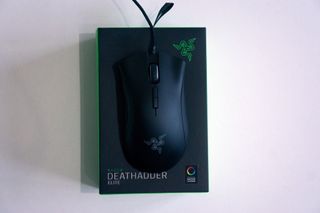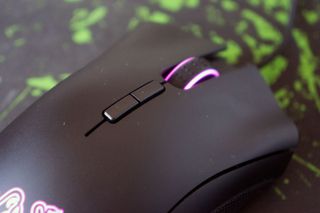The DeathAdder is the trusty gaming mouse from Razer that has been around for some time, a decade in fact. The company refreshed the snake this year with the launch of the DeathAdder Elite. It's ergonomic, solid-looking, and remains the jack-of-all-trades choice for many gamers.
So what's new with the DeathAdder Elite? There's the similar design and usual RGB Chroma lighting, but Razer has managed to improve the scroll wheel for enhanced performance and thrown in two buttons just underneath for good measure. Should you already own and be happy with a DeathAdder, this might not be enough to justify an upgrade, and that's okay. But if you haven't given a DeathAdder a spin… now may be the time.

With the addition of two more buttons, there are now a total of seven that can be customized using Razer's Synapse suite. This list includes a left and right-click, scroll wheel, two buttons for the thumb, and finally the two new clickers just below the scroll wheel itself. This provides more means of immediate input for gamers who like to dab into a little MOBA and MMO gaming here and there.
By default the new buttons are configured to increase or lower the DPI sensitivity without having to dive into Synapse, which is handy if you require different handling depending on game or situation. You can program them to do pretty much anything else, though. For League of Legends, I had the top-most button set to "4" (placing a trinket in-game) and the lower button set with a shortcut to make my champion dance. You absolutely have to drop that disrespect every now and then, right?

Interestingly, the DeathAdder Elite can go all the way up to 16,000 DPI, which is an insane setting on any mouse. Unlike cheaper options that have massive amounts of noise and interference when you attempt to move the on-screen pointer, it's not that bad here. The DeathAdder lets you crank the setting all the way up and enjoy vast screen coverage with very little in terms of physical strain. Of course, it's not going to be as accurate as lower settings, but it's not awful.
As is always the case when it comes to DPI and mouse sensitivity, it's all down to personal preference and your mileage may vary.
Hello, Jack

The best part about the DeathAdder (and the Elite in particular) is how well the mouse performs in a variety of tasks. Whether you need to be productive for a good hour, have a team set up for a MOBA or need to hop into a fast-paced shooter, you'll be able to change a few settings to get the experience perfected and the DeathAdder will handle like a dream. This is thanks to the sensor that can track up to 450 inches per second.
It was comfortable switching between Cities: Skylines, The Witcher 3, League of Legends, Skyrim Special Edition, and Overwatch. Take a peek at the specifications:
| Category | Specification |
|---|---|
| Sensor | 16,000 DPI optical sensor450 IPS / 50 g acceleration1000 Hz ultrapolling |
| Switches | Razer Mechanical Mouse switches |
| Scroll Wheel | Gaming-grade tactile scroll wheel |
| Buttons | 7 Programmable buttons |
| Lighting | Razer Chroma (16.8 million customizable colors) |
| Dimensions | 127mm (L) / 70mm (W) / 44mm (H) |
| Weight | 105g |
| Extra | Gold-plated USB connectorBraided fiber cable |

Chroma lighting really is gorgeous on Razer peripherals and it's a similar story with the DeathAdder. The scroll wheel and main Razer logo are customizable with Synapse and every shade of color looks stunning. Utilizing the company's own mechanical mouse switches, every click of a button feels solid with ample amounts of feedback.
I feel cheated as well, because I've spent hours actively hunting down things to dislike about the DeathAdder Elite and the best I've come up with are the pads underneath. I have a suspicion they will not last long enough when it comes to ferocious gaming sessions. But that's literally it. It's hard to test the wear and tear in but a few weeks, and since that's the only thing I could think of that's actually quite the praise.
Synapse is still fantastic

I've got to hand it to Razer: their Synapse suite is an absolute joy to use. It always has been. I've never really had a bad thing to say about the scope of customization one can enjoy when installing and playing with the software. The DeathAdder feels right at home with controls for not only the lighting and performance of the pointer, but also the array of buttons located on the unit.
Should you be one who frequently travels with their mouse — let's say to a LAN event — you'll definitely want to consider hooking yourself up with a Razer account, which can be used to store saved configurations. These, unfortunately, are not stored on the device itself. I highly recommend installing Synapse in general, though.
Should you buy it?

Pros:
- Sturdy, quality build
- Chroma lighting is gorgeous
- Sleeved cable & gold-plated USB
Cons:
- Not really an upgrade for DeathAdder owners
- Only for right-handed folk
So what do I make of the Razer DeathAdder Elite? I really like it. I think Razer has done a superb job of improving the already capable pointer and ensuring the DeathAdder remains the Jack of all trades option that can handle various titles, regardless as to what genre they belong to. With the pairing of Synapse and Chroma lighting, the mouse itself also looks incredible both in and without light.
If you need a replacement to your mouse and don't mind forking out $70, the DeathAdder Elite is a great investment. If you only play one time of game there are other niche mice available from Razer and competitors, and if you already own a DeathAdder I wouldn't hit that buy button without some serious thought.

Rich Edmonds was formerly a Senior Editor of PC hardware at Windows Central, covering everything related to PC components and NAS. He's been involved in technology for more than a decade and knows a thing or two about the magic inside a PC chassis. You can follow him on Twitter at @RichEdmonds.
